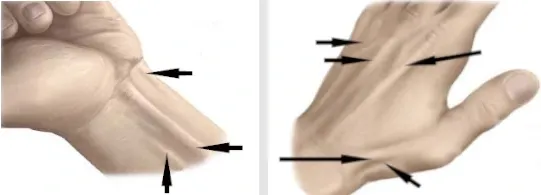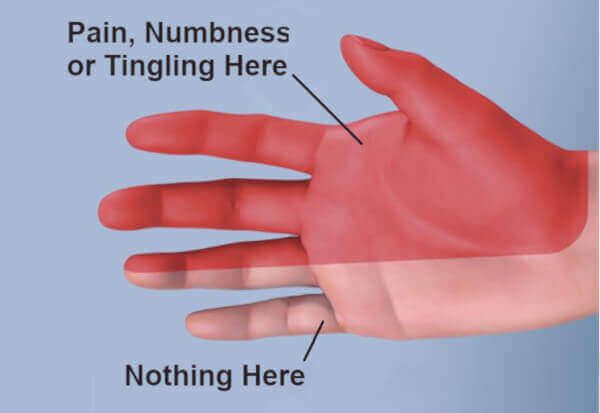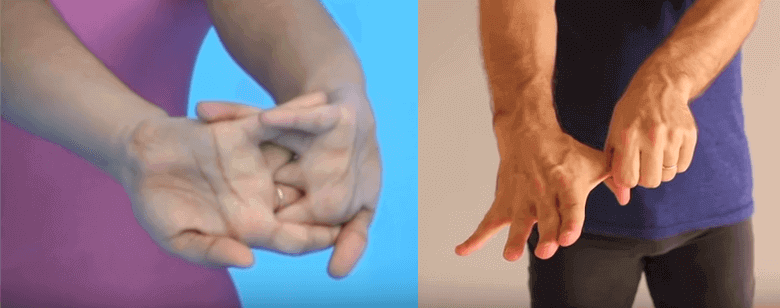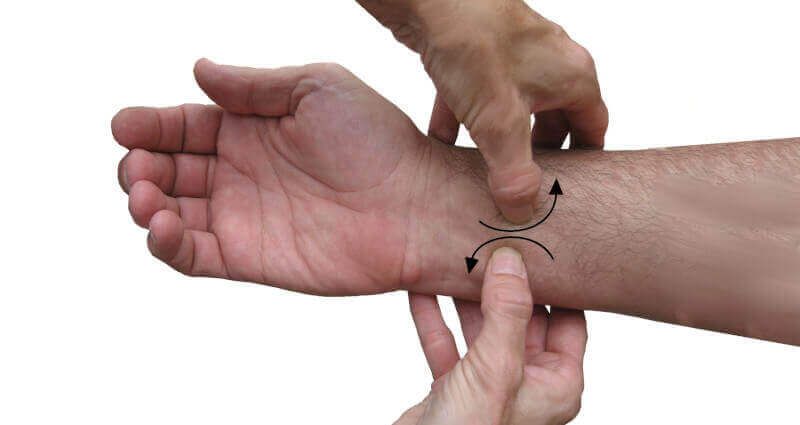Is This Wrist Tendonitis?
From Dr. Z - Carpal tunnel syndrome specialist
Is This Wrist Tendonitis?
Wrist tendonitis can cause severe pain in the fingers, wrist, hand or lower forearm. The pain is usually a dull ache. And it's especially achy when you move your wrist or grasp objects.
However, the pain can also be sharp or shooting. And it can be accompanied by tenderness and some swelling.
This article describes:
- What wrist tendonitis pain is all about
- How to distinguish it from other problems like carpal tunnel syndrome
- The best way to treat it effectively
Flexor vs extensor wrist tendonitis
Tendonitis (also spelled "tendinitis") is a very common disorder. It occurs when your wrist tendons inflame and swell.
The wrist tendons are the ropy cords felt just under your skin at your wrist joint. They attach muscles to your fingers, allowing the fingers to open or close.
There are 2 basic kinds of tendons in the wrist joint: flexors and extensors (see image below). Flexor tendons curl your fingers and are best seen on the palm side of your wrist. Extensor tendons open you fingers, and are best seen on the back side (knuckle side) of your hand.
Do you have wrist tendonitis or carpal tunnel syndrome?
There are several conditions that may cause wrist pain. Chief among them are wrist tendonitis and carpal tunnel syndrome. Both can have similar symptoms. In fact, many doctors often confuse these two disorders of the hand.
But carpal tunnel syndrome is a far worse and more debilitating condition. It's also much more difficult to treat it successfully.
Here's how to tell the difference between these two conditions:
- Wrist tendonitis affects your flexor and/or extensor tendons. In other words, pain can be on either the back side or palm side of your hand. Also, pain should be worse when your fingers are active and moving (like grasping).
- Carpal tunnel syndrome ONLY affects your flexor tendons, on the palm of the hand and first 4 fingers. In other words, pain (as well as numbness, tingling, weakness or clumsiness) is only on one side of your hand and fingers. Also, in its initial phase, carpal tunnel pain is mostly felt when your hand is resting (like when sleeping).
Still unsure of your condition?
Take this simple
self-test
to see if you have wrist tendonitis or carpal tunnel syndrome.
Treating wrist tendonitis
Unlike treating carpal tunnel syndrome, successfully getting rid of wrist tendonitis is much easier. There are 5 key ways to accomplishing this. (Actually, they're almost the same 5 ways to eliminate carpal tunnel syndrome, just not as aggressive or time-consuming.)
- Pain medicines
- Rest
- Nocturnal splinting
- Stretching exercises
- Myofascial release massage
Most cases of wrist tendonitis are mild enough to be treated with rest alone. A bit more pain may require rest in addition to one of the other treatments. However, more painful wrist tendonitis may require two, three or ALL of these treatments simultaneously.
1. Pain medicines to treat wrist tendonitis
The pain resulting from wrist tendonitis can range from annoying to debilitating. One of the best ways to cope with the severe pain is to temporarily use non-steroidal anti-inflammatory drugs (or NSAIDs). The most common over-the-counter NSAIDs include:
- Aspirin
- Ibuprofen (Advil, Motrin)
- Naproxen (Aleve)
- Acetaminophen (Tylenol, Paracetamol)
Use these and other pain medicines sparingly. And only use them when needed, and in combination with the other non-medicinal treatment methods below.
Note that the FDA has issued multiple warnings about using NSAID drugs on a chronic (daily) basis. That means never use them daily for more than 2 weeks. The reason is that they pose the risk of significant side effects when used chronically. Also, never use these drugs AT ALL during pregnancy after 20 weeks.
2. Rest to treat wrist tendonitis
The most simple and reliable way to treat flexor or extensor wrist tendonitis is resting your hand. Rest allows the damaged tendons to heal and restores them to their original, supple state.
Resting your hand also means not performing the activity (movement) that's causing the pain. Avoid the constant grasping, pinching, or grip-and-release motions of your fingers as much as possible. Cut down on typing, texting or gaming for just a short while. Doing so can make a tremendous difference in your pain levels.
For wrist tendonitis that's not too severe, 1-2 weeks of rest will usually result in full hand restoration and pain relief. But more severe cases will require more rest time. Severe cases will also require more (perhaps all) of the other treatments methods.
3. Nocturnal splinting to treat wrist tendonitis
Traditionally, doctors have prescribed a night splint (or brace) for your wrist to treat either flexor or extensor wrist tendonitis. And this still is sound advice.
A night splint keeps your wrist joint straight, in the "neutral" position. This is the position of the wrist where stress forces on the joint are minimal. We all bend our wrists when we sleep, and such bending can be harmful to tendons. But the splint will prevent over-bending.
Most people with wrist tendonitis should NOT wear a splint during the day. Why? Wearing a splint while your hand is working causes you to fight against the splint in addition to doing the activity. This results in isometric movements (pushing against a solid force), which means double-the-stress on your hand. So it's better to endure the wrist tendonitis pain than to make it worse in the long run.
The exception to not wearing a splint during the day is if you expect to over-stress your hand. If you will be lifting, doing a lot of grasping, etc. , then wearing a splint will temporarily protect against excessive harm to your wrist joint.
4. Stretching exercises to treat wrist tendonitis
The root cause of wrist tendonitis is damage to the tendon tissue which produces inflammation and swelling. That inflammation is associated with microscopic adhesions between tiny strands of tendon tissue.
So one of the best ways to get rid of those adhesions is to stretch your tendons in a relaxed, controlled manner using stretching exercises. The exercises can break up the adhesions. That in turn reduces inflammation and pain.
The time it takes to eliminate wrist tendonitis using stretching exercises depends on the severity of the condition. In less severe cases, symptoms will disappear in 2-3 weeks of routine (5-10 times a day) stretching exercises. More severe cases may require 4-6 weeks, and perhaps 10-20 stretching exercises per day. The good news is that these exercises are short, taking only seconds to complete.
Stretching the flexor and extensor tendons is simple. Just hyper-flex or hyper-extend your fingers. Do it slowly, and for short bursts (2-5 seconds) for each finger, every hour.
There are literally thousands of self-help videos demonstrating how to perform these exercises. Search for "wrist flexor stretching exercises" or "wrist extensor stretching exercises" (depending on where your pain is located). Almost all videos show the same exercises.
5. Myofascial release massage to treat wrist tendonitis
Myofascial release literally means to un-stick the adhesions holding muscle to the fascia. (Fascia is the tissue holding most other tissues and organs together.) The same principle applies to getting rid of the adhesions between tendons.
Use myofascial release massage for the most severe cases of wrist tendonitis. Start by identifying the tendons which need treatment (flexor or extensor side). Then, with your opposite thumb, make short, circular motions on the skin over the tendons. The effect should result in a "kneading" motion.
It's much better to have a partner do this for you using both of their thumbs. They should make circular motions in opposite directions. This twists and pulls the adhesions below the skin for maximum benefit.
Perform the myofascial release massage at least twice a day. But more massages are better, especially for severe cases of wrist tendonitis. As with stretching exercises, less severe symptoms will disappear in 2-3 weeks of twice-daily massages. Severe cases may require 4-6 weeks of twice-daily massages.
Summary
Wrist tendonitis is a painful condition of the flexor or extensor tendons in your wrist. But treatment is relatively simple. One or more of a combination of rest, nocturnal splinting, stretching exercises, and myofascial release massage should eliminate even the most stubborn and severe cases of this condition.








